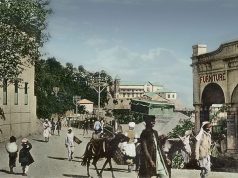By Dr Ashish Kumar
Each year, the library and information science community in India observes 12 August as National Librarians’ Day, to commemorate the birth anniversary of Dr Shiyali Ramamrita Ranganathan (1892–1972), a scholar, mathematician, philosopher, educationist, and the undisputed Father of Library Science in India. Dr Ranganathan’s contributions were path-breaking and continue to shape not only the Indian libraries landscape but also global discourse in librarianship.
Born in a small town called Shiyali (now Sirkazhi) in Tamil Nadu in 1892, Dr Ranganathan initially pursued a career in mathematics. He earned his Master’s degree and became a professor of mathematics. His entry into the library profession was not by choice, but by chance, when he was appointed as the first librarian of the University of Madras in 1924.
At that time, the concept of library science as an academic discipline was largely absent in India. Libraries were more repositories of books than centres of learning and user service. But Dr Ranganathan’s approach to librarianship was transformative. In 1924–25, he went to University College London for formal training in library science under WC Berwick Sayers. Upon his return, he set out on a mission to revolutionise library services in India.
Landmark Contributions to Library Science
- Five Laws of Library Science (1931)
Dr Ranganathan’s Five Laws of Library Science remain the philosophical bedrock of modern librarianship. These laws, though formulated in the 1930s, are visionary and timeless. They emphasise the dynamic relationship between the user, the library, and the materials. The laws advocate for access, inclusivity, service orientation, efficiency, and continual growth.
- Colon Classification System
Dissatisfied with the rigidity of existing classification systems like Dewey Decimal and Library of Congress Classification, Dr Ranganathan developed the Colon Classification System, a faceted, analytico-synthetic classification system. Using the PMEST formula (Personality, Matter, Energy, Space, Time), it allowed a multidimensional and flexible organisation of subjects. It was a significant innovation in knowledge organisation and remains a major contribution to classification theory.
- Chain Indexing
Dr Ranganathan also introduced Chain Indexing, an indexing method that derived subject headings from the class number, providing a logical and structured approach to indexing documents. This method helped link keywords in hierarchical relationships and enhanced subject retrieval.
- Classified Catalogue Code (CCC)
To bring uniformity and precision in cataloguing, Ranganathan developed the Classified Catalogue Code (CCC), which provided detailed rules for bibliographic description and subject indexing. CCC emphasised the value of cohesive and logically linked catalog entries and was tailored for use with the Colon Classification.
- Library Education and Institution Building
He played a pivotal role in establishing formal library science education in India. He was instrumental in launching diploma and degree programmes in LIS, including at the University of Madras, Banaras Hindu University, and the University of Delhi. He also helped found professional bodies such as the Indian Library Association (ILA) and was associated with DDC and IFLA globally.
Recognition and Awards
In recognition of his lifelong service to the nation and his pioneering academic and professional work, Dr SR Ranganathan was awarded the Padma Shri by the Government of India in 1957. He was also a nominated member of the Indian Parliament (Rajya Sabha) from 1952 to 1957, where he continued to advocate for education and library development at the national level.
The Changing Role of Librarians in the Digital Age
In today’s information landscape, libraries are no longer defined merely by their physical collections. The role of the librarian has expanded from custodian of books to information manager, knowledge navigator, technology facilitator, and research partner.
Let’s explore how Dr Ranganathan’s principles continue to provide guidance in this transition:
- From “Books are for use” to “Information is for access”
Modern libraries offer access to a range of formats: print, digital, audio, and video-based resources. Dr Ranganathan’s first law is reflected in today’s emphasis on usability, discoverability, and accessibility. Whether through institutional repositories, digital libraries, or remote access platforms, libraries are maximising the use of information resources.
- Personalised Information Services
“Every reader his or her book” and “Every book its reader” are being operationalised usage-based recommendation systems, federated search tools, and user profiling. Librarians today focus on understanding user needs, curating content, and delivering customised information services.
- Saving Reader Time in the Digital Age
In an age of information overload, saving the user’s time is more important than ever. This includes user education, intuitive library interfaces, metadata enhancement, and digital literacy programmes. It also includes reference services, citation management tools, and research consultations offered by librarians to research scholars and students.
- The Library as a Growing Organism
Libraries are embracing cloud computing, mobile apps, makerspaces, virtual reality, and open science. They are hosting webinars, exhibitions, research support services, and MOOCs. The idea that a library must grow and evolve with its users and environment is central to Ranganathan’s fifth law.
A Legacy that Lives On
Dr SR Ranganathan was far ahead of his time. His philosophies are not relics of the past, but beacons for the future. As libraries navigate the challenges of digital transformation, user diversity, and data-driven ecosystems, Ranganathan’s work offers a foundation that is both ethical and functional.
His call for a “library movement” was not just about buildings or books, it was about creating an informed, empowered, and equitable society.
As we celebrate his legacy, we are reminded that the spirit of librarianship lies in service, scholarship, and adaptability. It is now upon today’s library professionals to reinterpret and revive this legacy in ways that address contemporary realities while honouring timeless principles.
Let us not merely remember Dr Ranganathan—let us practice his vision.
(Dr Ashish Kumar is University Librarian, Doon University, Dehradun)







